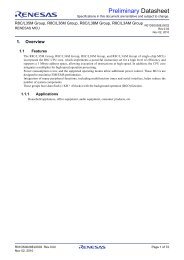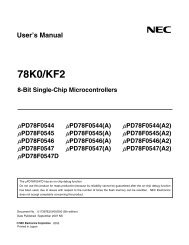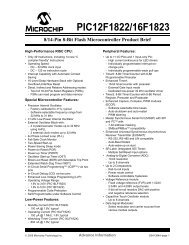xmega a3u - Elfa
xmega a3u - Elfa
xmega a3u - Elfa
Create successful ePaper yourself
Turn your PDF publications into a flip-book with our unique Google optimized e-Paper software.
XMEGA A3U<br />
During interrupts or subroutine calls, the return address is automatically pushed on the stack.<br />
The return address can be two or three bytes, depending on program memory size of the device.<br />
For devices with 128KB or less of program memory, the return address is two bytes, and hence<br />
the stack pointer is decremented/incremented by two. For devices with more than 128KB of program<br />
memory, the return address is three bytes, and hence the SP is decremented/incremented<br />
by three. The return address is popped off the stack when returning from interrupts using the<br />
RETI instruction, and from subroutine calls using the RET instruction.<br />
The SP is decremented by one when data are pushed on the stack with the PUSH instruction,<br />
and incremented by one when data is popped off the stack using the POP instruction.<br />
To prevent corruption when updating the stack pointer from software, a write to SPL will automatically<br />
disable interrupts for up to four instructions or until the next I/O memory write.<br />
After reset the stack pointer is initialized to the highest address of the SRAM. See Figure 7-2 on<br />
page 14.<br />
6.8 Register File<br />
The register file consists of 32 x 8-bit general purpose working registers with single clock cycle<br />
access time. The register file supports the following input/output schemes:<br />
• One 8-bit output operand and one 8-bit result input<br />
• Two 8-bit output operands and one 8-bit result input<br />
• Two 8-bit output operands and one 16-bit result input<br />
• One 16-bit output operand and one 16-bit result input<br />
Six of the 32 registers can be used as three 16-bit address register pointers for data space<br />
addressing, enabling efficient address calculations. One of these address pointers can also be<br />
used as an address pointer for lookup tables in flash program memory.<br />
8386B–AVR–12/11<br />
10
















